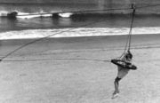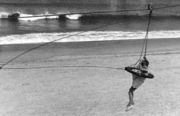
Breeches buoy
Encyclopedia
A breeches buoy is a crude rope-based rescue
device used to extract people from wrecked vessels, or to transfer people from one location to another in situations of danger. The device resembles a round emergency personal flotation device
with a leg harness attached. It is similar to a zip line.The breeches buoy was usually deployed from either ship to ship, or ship to shore using a rocket
or a lyle gun
, and allowed single person evacuations. A line is attached to the ship, and the person being rescued is pulled to shore in the breeches buoy which rides the line similar to a zip line.

Before the event the crew sets up their equipment, which includes a thin shot line attached to the tower simulating the crow's nest
of a sinking ship, a high line made of a hawser
, a block and tackle, a deadman with a cleat, an endless whip with a block, a chair, and shear legs. Once the equipment is prepared, two scouts go up to the tower (these scouts must wear harnesses for safety in most of today's competitions). The coxswain
calls the four or five scouts remaining on the ground to attention.
No further talking is allowed by anyone except for the coxswain and the two participants in the tower. No communication other than yes and no arm signaling is allowed between the tower and ground. At the go signal, time begins and does not stop until the participant who is being rescued from the tower is on the ground and the coxswain calls the crew to attention again.
One member of the ground crew ties the whip block tail to the shot line. The coxswain signals the tower, and the tower returns the affirmative signal. The tower then hauls the whip up to them on the shot line, and ties the whip block tail to the mast with two half hitches and a round turn. The tower signals to the coxswain who returns the signal. The ground crew attaches the high line through the chair to the endless whip and raises the high line to the tower. Once the high line reaches the tower, it is attached to the mast with a round turn and two half hitches and a signal is passed to the coxswain.
The ground crew ties a bowline on a bight
into the high line and hooks it to the blocks. The crew hauls on the blocks tightening the high line and secures it to the deadman with a cleat hitch. The shear legs are put in place. The chair is attached to the endless whip and raised to the tower. When everything on the ground is set, the coxswain signals the tower. One member of the tower crew gets in the chair, clips in, and signals the ground crew. The rider must sit and is not allowed to "surf" the chair for added speed as popularized by Stefan Geiger. The rider must be stopped in a controlled manner and removed from the chair. Time stops when the ground crew is called to attention by the coxswain.
Judges are responsible for halting progress if they deem a situation unsafe, and for correcting the situation as well as assessing penalties for violations such as talking and crossing the water line.
Rescue
Rescue refers to responsive operations that usually involve the saving of life, or prevention of injury during an incident or dangerous situation....
device used to extract people from wrecked vessels, or to transfer people from one location to another in situations of danger. The device resembles a round emergency personal flotation device
Personal flotation device
A personal flotation device is a device designed to assist a wearer, either conscious or unconscious, to keep afloat.Devices designed and approved by authorities for use by...
with a leg harness attached. It is similar to a zip line.The breeches buoy was usually deployed from either ship to ship, or ship to shore using a rocket
Rocket
A rocket is a missile, spacecraft, aircraft or other vehicle which obtains thrust from a rocket engine. In all rockets, the exhaust is formed entirely from propellants carried within the rocket before use. Rocket engines work by action and reaction...
or a lyle gun
Lyle gun
Line-throwing guns are most often referred to as Lyle Guns, after their inventor David A. Lyle. They were used from the late 19th century to 1952, when they were replaced by rockets for throwing lines.-History:...
, and allowed single person evacuations. A line is attached to the ship, and the person being rescued is pulled to shore in the breeches buoy which rides the line similar to a zip line.

Competition
In Sea Scouts, use of a breeches buoy has become one of the events that are competed in at regattas such as the Old Salts' Regatta and the Ancient Mariner Sea Scout Regatta. The competition simulates an actual breeches buoy rescue situation.Before the event the crew sets up their equipment, which includes a thin shot line attached to the tower simulating the crow's nest
Crow's nest
A crow's nest is a structure in the upper part of the mainmast of a ship or structure, that is used as a lookout point.This position ensured the best view of the approaching hazards, other ships or land. It was the best device for this purpose until the invention of radar.In early ships it was...
of a sinking ship, a high line made of a hawser
Hawser
Hawser is a nautical term for a thick cable or rope used in mooring or towing a ship. A hawser passes through a hawsehole, also known as a cat hole, located on the hawse....
, a block and tackle, a deadman with a cleat, an endless whip with a block, a chair, and shear legs. Once the equipment is prepared, two scouts go up to the tower (these scouts must wear harnesses for safety in most of today's competitions). The coxswain
Coxswain
The coxswain is the person in charge of a boat, particularly its navigation and steering. The etymology of the word gives us a literal meaning of "boat servant" since it comes from cox, a coxboat or other small vessel kept aboard a ship, and swain, which can be rendered as boy, in authority. ...
calls the four or five scouts remaining on the ground to attention.
No further talking is allowed by anyone except for the coxswain and the two participants in the tower. No communication other than yes and no arm signaling is allowed between the tower and ground. At the go signal, time begins and does not stop until the participant who is being rescued from the tower is on the ground and the coxswain calls the crew to attention again.
One member of the ground crew ties the whip block tail to the shot line. The coxswain signals the tower, and the tower returns the affirmative signal. The tower then hauls the whip up to them on the shot line, and ties the whip block tail to the mast with two half hitches and a round turn. The tower signals to the coxswain who returns the signal. The ground crew attaches the high line through the chair to the endless whip and raises the high line to the tower. Once the high line reaches the tower, it is attached to the mast with a round turn and two half hitches and a signal is passed to the coxswain.
The ground crew ties a bowline on a bight
Bowline on a bight
The Bowline on a bight is a knot which makes a pair of fixed-size loops in the middle of a rope. Its advantages are that its loops do not slip and it is reasonably easy to untie after being exposed to a strain. This knot can replace the figure-eight knot when tying into a climbing harness...
into the high line and hooks it to the blocks. The crew hauls on the blocks tightening the high line and secures it to the deadman with a cleat hitch. The shear legs are put in place. The chair is attached to the endless whip and raised to the tower. When everything on the ground is set, the coxswain signals the tower. One member of the tower crew gets in the chair, clips in, and signals the ground crew. The rider must sit and is not allowed to "surf" the chair for added speed as popularized by Stefan Geiger. The rider must be stopped in a controlled manner and removed from the chair. Time stops when the ground crew is called to attention by the coxswain.
Judges are responsible for halting progress if they deem a situation unsafe, and for correcting the situation as well as assessing penalties for violations such as talking and crossing the water line.

